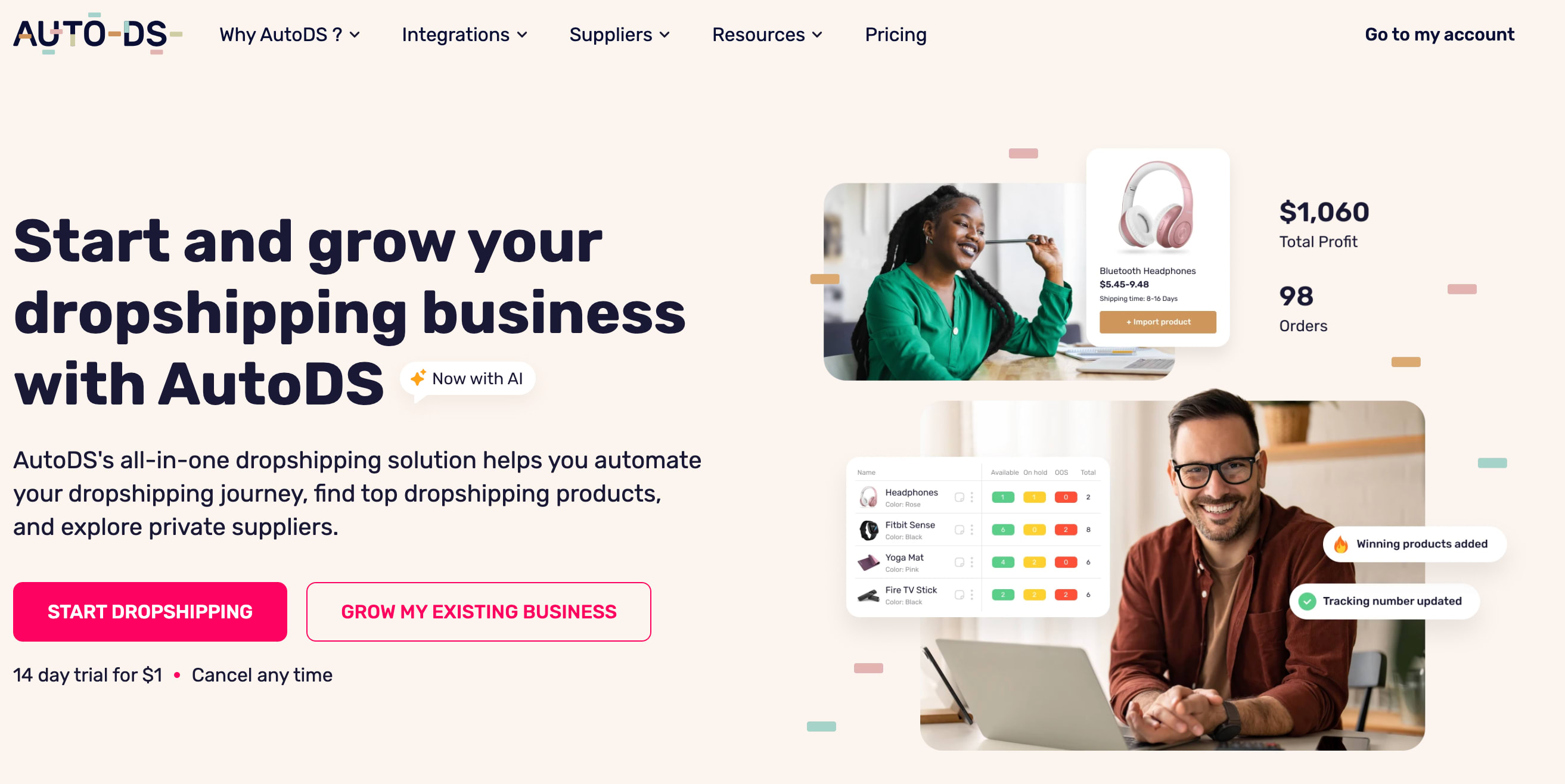What is Dropshipping and How Does It Work?
Learn how dropshipping works, the essentials of this business model, and how to put it into practice successfully!
 March 7, 2024
March 7, 2024 8 minute reading
8 minute reading
What is dropshipping? This question will likely arise if you are interested in e-commerce and its various paths and alternatives. Dropshipping is an easily accessible business model through which you can set up a store and start selling without requiring extensive experience or knowledge on the subject.
Since the expansion of digital businesses, it’s easier to consider replacing traditional 9-to-5 jobs with more flexible work that allows us to grow or adding a side hustle to complement our primary job. In this article, we will cover the basic concepts of this model, its benefits, challenges, and how it works so you can decide if it’s a good fit for your project or business venture.
What Is Dropshipping?

Shutterstock
Let’s start from the beginning: What is dropshipping? Dropshipping is an online business model in which we don't need to maintain inventory or stock, nor do we require a physical location to set up our store. This is possible by partnering with a supplier, who stores the products and ships them to customers.
Here’s how it works: the customer purchases in our store, we forward the order to the supplier, and they send the product directly to the customer. With this setup, dropshipping becomes a low-risk business model that doesn’t require a high initial investment.
Well-managed, a dropshipping business can generate a lot of sales. According to Statista, over the six years between 2021 and 2026, the value of the market size is forecast to grow to 476.1 billion U.S. dollars.
Unlike a traditional business, where we have to invest in renting physical stores or buying large quantities of products without knowing if they will sell, dropshipping gives us the flexibility to experiment with different products, plan various strategies, and start selling without taking on too much risk.
In dropshipping, our main tasks are building a brand identity that makes us stand out in the competitive landscape and encouraging potential customers to choose our products. Of course, this requires partnering with a reliable supplier, selecting a niche where we can grow, and implementing the necessary marketing strategies.
Is Dropshipping Legal?
Now that we’ve answered the question, "What is dropshipping?" you’re probably wondering if it’s legal. Due to its flexibility and scalability, we might think this model has a catch, but that’s not the case. Dropshipping is a completely legitimate business model.
Of course, you need to consider the different regulations and laws in the region where we establish your store and the policies of the selling channels. You should also be mindful of product categories we should avoid selling or those requiring specific permits.
How Does Dropshipping Work?
Whatever niche you choose, dropshipping maintains some standard operational features. First, search for products and suppliers that guarantee good quality and reliable shipping times. Next, you must create an online store through a selling channel, which will serve as the storefront to showcase your brand. Once we list the products in the store, customers will visit and purchase.
After a product is purchased, your role as a dropshipper is to forward the order to the supplier, who will handle the shipping. In this process, we profit from the difference between the supplier's price and the price at which we sell the product in our store. We must oversee every order from when a customer purchases it until the product reaches them.
To summarize, we can describe dropshipping in three steps:
The customer buys a product from your store and makes a payment.
You forward the order details to the supplier and make a payment.
The supplier ships the product to your customer.
Dropshipping Pros & Cons: Is It Worth It?
This business model, like any other, has its pros and challenges. Among the main advantages of dropshipping are:
Low Startup Costs: As mentioned earlier, there’s no need to invest in inventory, rent physical spaces, hire employees, or cover similar expenses that you would face with a traditional business. This naturally results in a significant risk reduction.
Flexibility: The structure of a dropshipping business allows you to manage it from anywhere in the world with an internet connection. Additionally, you can set your work schedule.
Wide Product Variety: Dropshipping lets you experiment with different product categories and explore various niches without requiring large financial investments.
Scalable Model: You can quickly grow your business by adding new products or expanding into new markets without worrying about storage limitations.
Fast Start: Thanks to its characteristics, dropshipping allows you to enter the market quickly without taking on excessive risks or sacrificing your life savings.
Easily Replace & Test Products: Another advantage of dropshipping is that it allows you to test and replace products in your store. Testing an item ensures its quality, which is essential to verify that what you offer in your store works as expected.
When it comes to the obstacles you may encounter on your path as a dropshipper, here are the main ones:
High Competition: The numerous advantages of dropshipping attract many sellers and entrepreneurs worldwide, making the market more competitive. Don’t worry! You can make your store stand out by choosing the right niche and building a brand identity that reflects your values and goals.
Limited Control Over Products: Since you don't handle the products directly, you have less control over their quality and other tasks the supplier manages, such as shipping. We can address this by thoroughly researching suppliers to find one that guarantees the quality and service you need.
Lower Profit Margins: Since many competitors use the same model, pricing can become highly competitive, reducing profit margins. However, with effort and smart strategies, you can increase sales and diversify your product offerings to boost profits.
As we can see, the advantages of dropshipping far outweigh the disadvantages. On the other hand, we refer to "disadvantages" as obstacles and challenges that we can solve in different ways. If we use automation tools for various aspects of our store, we can prevent these drawbacks and boost our sales!
The Dropshipping Basics You Should Know About

Shutterstock
Now that you know what dropshipping is and its main benefits, let’s dive deeper into the most critical aspects you shouldn’t overlook when setting up a functional store that helps you generate profits.
Dropshipping Selling Channels
A selling channel is a platform you'll use to launch your dropshipping business. It’s where you'll build your store from scratch to showcase your products and connect with your ideal audience. Broadly speaking, there are two selling channels: marketplaces and customizable eCommerce platforms.
You benefit from a platform that lists products from multiple sellers when using marketplaces like Facebook Marketplace or eBay. In this case, you can leverage the platform's user trust and massive traffic.
On the other hand, using an eCommerce website gives you more freedom to tailor your store’s aesthetics and functionality. Additionally, it keeps your customers focused on your products without distractions from competitors. Let’s explore some of the top-selling channels.
eBay
eBay is widely recognized as a diverse shopping platform, offering countless products and supporting dropshipping within its model. It's a reliable place to kick off your dropshipping venture.
Key Features:
Easy to get started
Millions of product options
Requires minimal investment
Strong, global customer base
Quick shipping times
Shopify
If you start an e-commerce business on Shopify, you can create and manage online stores without coding knowledge. It offers a hosted platform with multiple customization options, making it easier to stand out.
Key Features:
Fully hosted eCommerce platform
Customization with professional themes
Built-in shipping discounts
24/7 customer support
Easy store migration options
Amazon
Amazon gives you access to a large audience and established marketplace trust. It’s a great option for reaching millions of potential buyers.
Key Features:
Free organic traffic
No warehouse costs
Wide range of product categories
Reliable order fulfillment infrastructure
Easy-to-scale operations
Etsy
Etsy is ideal if you’re planning to dropship unique or handmade products. It offers a niche market with lower competition compared to Amazon or eBay.
Key Features:
Free organic traffic
Focused niche platform
Branding potential with handmade items
Higher profit margins
Lower upfront costs
Facebook Marketplace / Facebook Shops
These platforms let users buy and sell directly on Facebook. They are less competitive, offering great opportunities for new dropshippers.
Key Features:
No need for a separate website
Low selling fees (5% or $0.40 per transaction)
Access to Facebook’s organic traffic
Minimal seller competition
Easy setup and management
TikTok Shop
TikTok Shop is a relatively new channel that is growing in popularity. It allows you to showcase products through engaging videos and tap into TikTok’s viral culture.
Key Features:
Leverage viral trends for sales
Access to a young, engaged audience
Integration with TikTok’s ad platform
No upfront fees
Easy product promotion through influencers
WooCommerce
WooCommerce is an open-source plugin for WordPress that enables you to build a customized store. It offers many plugins and themes to streamline your dropshipping operation.
Key Features:
Full customization options
High scalability
Extensive plugin library
Great content management system
Easy product management
Wix
Wix is a user-friendly website builder, perfect for dropshippers who want to set up a store quickly. It offers ease of use and affordable pricing.
Key Features:
Simple store-building process
Access to the Wix App Market
Flexible customization options
No seller limits
Global market reach
The Importance Of Selecting Dropshipping Suppliers
We have mentioned suppliers more than once in this article, and for good reason. Since they are an essential part of the structure of any dropshipping business (customer-seller-supplier), they directly influence the success or failure of our business.
Think of it this way: if a customer buys a product from your store and it arrives broken, too late, or doesn’t arrive, you will face the problem, affecting your brand image and, consequently, your sales. Choosing the right supplier isn’t too complicated if we base our choice on the following criteria:
Shipping Speed: Technology has made everything move at a breakneck pace lately, and in this regard, online shoppers expect you to meet their demands quickly. The shipping speed of our products is one of the most influential factors when choosing a supplier.
Clear Return Policies: The phrase "the customer is always right" also applies in dropshipping. Therefore, it’s essential that if a buyer wants to return or replace a product, they receive a friendly and considerate response that leaves them satisfied.
Customer Service: In line with the previous point, we should consider that the supplier represents your business somehow. It is of no use if we treat the customer correctly, but the supplier fails to respond or responds unfavorably.
Product Quality: Although it may sound obvious, we must ensure that the products in our store are good quality.
You can evaluate these points by requesting different samples before committing to a supplier. It’s advisable to order samples not only from our home but also from the homes of family and friends to check shipping times to different locations, product quality, and their policies.
Increase Profits With Dropshipping Automation

AutoDS
Automation is crucial for streamlining operations and maximizing efficiency when starting a dropshipping business. While you can do everything manually, managing a dropshipping business will reveal that responsibilities involve many small, routine tasks that can be exhausting or tedious.
Automation tools can help you manage your store more effectively, allowing you to focus on marketing and customer engagement rather than the day-to-day tasks that can consume valuable time. Various dropshipping tools are available, each offering unique features that can simplify different aspects of your business. Some tools allow you to import products from suppliers easily, while other platforms focus on print-on-demand services.
Other tools offer a comprehensive solution for your dropshipping business, such as AutoDS, an all-in-one automation platform explicitly designed for businesses. AutoDS streamlines processes like product research, order fulfillment, and inventory management, enabling you to run your store smoothly and efficiently.
Key Features of AutoDS:
Automated Product Importing: Effortlessly import products from various suppliers, saving you time and reducing the chance of errors.
Real-Time Price and Stock Monitoring: Automatically adjust prices and inventory levels based on supplier updates, ensuring your store remains competitive and well-stocked.
Order Fulfillment Automation: Simplify the order fulfillment process, allowing you to focus on growing your business rather than getting bogged down in logistics.
Multi-Channel Support: Manage your products and orders across multiple selling channels, increasing your reach and potential sales.
Business Registration
As we manage a business that generates income, it's essential to register it in our country of residence.
Although many dropshippers choose not to register their business to avoid double taxation—once from their regular job and again from dropshipping—this approach poses significant risks if discovered. Hence, we should register our business just like any other.
Each country has its regulations for business registration, so it's advisable to consult with a local accountant for detailed guidance on the registration process.
Dropshipping Taxes
Generally, governments worldwide require you to pay income taxes on all sources of revenue. To navigate these regulations, it's essential to consult a local accountant for clarity on tax rules.
For example, when importing products into the UK, you must consider two types of taxes: VAT and Customs Duty. The VAT is set at 20% for imported goods and is payable to the delivery company or at the time of parcel collection.
On the other hand, Customs Duty is approximately 2.5% on packages valued over £135. Additionally, you might incur around 10% tax when purchasing items from suppliers. When customers buy through your selling channels, such as eBay, they are charged tax by eBay, which you receive. eBay then deducts that tax amount from your earnings.
This means you're fulfilling tax obligations in both purchasing and selling scenarios. To better understand your tax responsibilities, regardless of location or where you plan to dropship to or from, we recommend reading this guide, which has everything you need to know.
Niche And Product Selection
Once you have a solid understanding of what dropshipping is, how to start selling, which taxes to pay, and other essential details, you’ll likely ask yourself: What should I sell in my store? Choosing a niche and the products that go with it will shape many of your future strategies! Selling auto parts is not the same as selling handbags or jewelry.
A niche refers to a specific market segment with particular demands and characteristics. Niches are generally divided into two types: seasonal niches and evergreen niches. Seasonal niches consist of products that perform exceptionally well during specific times or events, such as Christmas decorations, Halloween costumes, or items tailored to a particular season, like pool accessories or beach gear.
On the other hand, evergreen niches have consistent demand throughout the year, such as baby clothes, pet products, or beauty items.
To find the perfect niche for your business, ask yourself what topics interest you the most or where you already have some basic knowledge. Choosing a niche you’re somewhat familiar with will give you a head start in developing your store. However, the most crucial step is analyzing the demand for those products. That's why we must conduct proper product research.
Tools like Google Trends can provide insights into how often a product is searched for when it's in demand, what related keywords customers search for, and much more valuable data to help you list and sell your products.
You can also benefit from browsing the selected product sections on various platforms, such as best-seller lists, to identify items with proven demand.
Here are a few things we recommend analyzing to determine whether a product has good sales potential:
Fulfills a specific demand: Does the product solve a problem or meet a need?
High search volume: Are people actively looking for it online?
Trending or evergreen: Is it a seasonal trend or always in demand?
Competitive pricing: Can you offer a competitive price while still maintaining a profit margin?
Positive reviews and quality: Do similar products have good feedback from customers?
Low shipping costs and delivery time: Will customers receive it quickly without high shipping fees?
Considering these factors will help you select the right products for your store and increase your chances of success in dropshipping.
Forbidden Items
Here are some items you should avoid selling in your store, as they can lead to account bans or even legal issues:
Dangerous Products: Includes items that can cause harm, such as weapons, explosives, toxic substances, or flammable goods.
Age-Restricted Items: Products like alcohol, tobacco, and adult content are restricted by age regulations.
Unregulated Medications and Supplements: Covers drugs, vitamins, or health products lacking official approval (e.g., from the FDA or equivalent authorities).
Illegal or Restricted Products: These include items that violate local or international laws, such as pirated copies, counterfeit goods, or products subject to trade sanctions.
Marketing Strategies: A Must!
It’s pointless to choose the right product, have a beautiful store, and the best suppliers if your customers don’t know about it. Marketing connects what you’re selling with those who want to buy it. That’s why it’s essential to implement effective marketing strategies for your store.
This way, you’ll attract customers, build loyalty, and increase your sales. Of course, the strategy will depend on the niche you focus on, the selling channel you use, and the target audience you identify. Here are some ideas to help you promote your business:
Email Marketing
Email marketing is a great way to generate free traffic. It allows you to engage with existing customers or attract new ones. Offering incentives like discounts or newsletter sign-ups is helpful for collecting customer emails. Once you’ve built an email list, you’ll have a direct line of communication to promote products and encourage purchases.
Influencer Marketing
Influencer marketing offers one of the highest ROIs for your dropshipping business. Influencers bring niche expertise, credibility, and a pre-established audience, making them a powerful resource for promoting your products.
Of course, costs will vary depending on the influencer's reach, platform presence, and following size.
Blog & Videos
Creating blogs or product videos is an excellent way to drive organic traffic to your store. A well-written, SEO-optimized blog that offers valuable content can attract an audience and strengthen your brand’s visibility. It’s a subtle way to market your products and motivate purchases.
Similarly, product videos allow you to highlight key features and showcase your products in a way that encourages buyers. Make your videos engaging, visually appealing, and shareable to stand out.
Customer Service Needs To Be Exceptional

Shutterstock
We can't overlook an essential aspect—one that’s crucial not only for a dropshipping business but for any type of store or venture: customer service must always be as good as possible.
Ultimately, it’s the customer who determines the success of our store. We need to respond quickly, be friendly, and provide accessible communication channels for customers to express themselves. A section with positive reviews from satisfied customers can boost our sales, while a series of bad reviews could harm our reputation in the eCommerce world.
Here are some tips for exceptional customer service:
Respond to inquiries within 24 hours to show customers they are a priority.
Use clear and polite language, even when addressing complaints.
Provide multiple contact options (e.g., email, chat, and social media).
Be proactive in resolving issues before they escalate.
Follow up after a sale to ensure customer satisfaction and build loyalty.
Encourage feedback to identify areas for improvement.
Frequently Asked Questions
Why Should I Start Dropshipping?
Dropshipping allows you to start an online business with low upfront costs and no need for inventory. It’s a flexible model that lets you focus on marketing and customer service while suppliers handle shipping.
Is It Worth Starting A Dropshipping Business In 2025?
Yes, dropshipping remains a viable business model in 2025, with growing eCommerce trends and automation tools making it easier to manage. Success depends on choosing the right products and suppliers.
Is Dropshipping The Same As Ghost Commerce?
While both models involve selling without holding inventory, ghost commerce includes more business models like affiliate marketing or print-on-demand, whereas dropshipping focuses on third-party suppliers.
Is It Easy To Start Dropshipping?
Yes, starting is relatively simple since you don’t need inventory, but building a successful business takes effort in product selection, marketing, and customer service.
Conclusion
Great! If you were wondering, "What is dropshipping?" we assume you now have a much better understanding of how to answer that! Within the vast universe of eCommerce, these more flexible models allow us to start stores and begin selling in less time and with less investment than traditional buying and selling methods require.
If you solve the main aspects, partner with the right suppliers, and leverage automation tools and marketing strategies, starting a dropshipping business is not complicated! This article serves as a guide to help you start envisioning your own business, but remember, we’re here if you need a hand!
Good luck!



